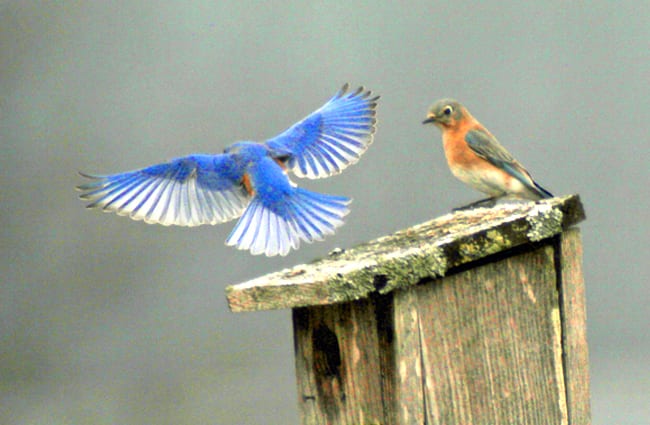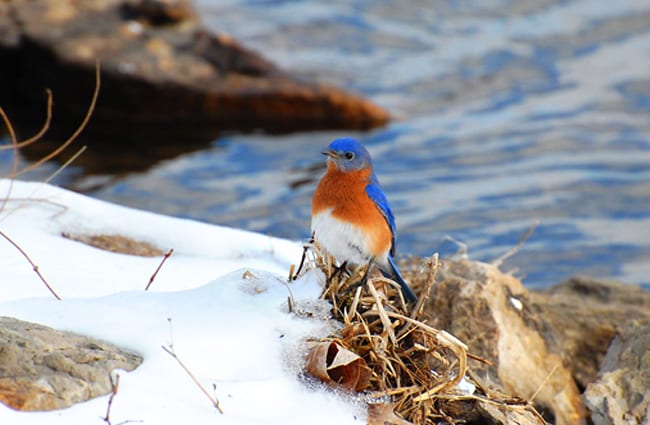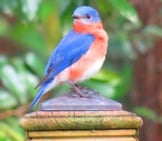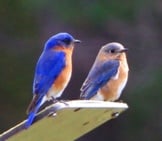The Bluebird comprises a small group of songbirds in the Turdidae family. There are three different species, all of which live in North America and Central America. These are the eastern, western, and mountain Bluebirds. As their name suggests, all three species have bright blue plumage. Read on to learn about the Bluebird.
Description of the Bluebird
The three different species have slightly different plumage, but similar body shapes. Their bodies are rather round and stocky, and they have short pointed bills. Eastern Bluebirds have blue heads, backs, and wings, light orange chests, and white undersides.
Westerns are similar to Easterns, but have darker orange, and grey undersides. Mountain Bluebirds have blue plumage on their heads and backs, and light blue plumage on their chests.
Interesting Facts About the Bluebird
These beautiful birds have several different traits and adaptations that make them unique. Learn more about these beautiful birds below.
- He’s a Looker – Males are quite colorful, but female Mountain Bluebirds don’t really care about looks. A female Mountain Bluebird only looks for one thing when choosing a mate, his nest location. If he doesn’t have a great nesting spot, she isn’t interested.
- Dedicated Dad – Female Bluebirds take over most of the incubation duties. While she is incubating the eggs, dad goes out and catches food for her. Some even have signals that let the males know when they are hungry.
- Hole Lotta’ Nest – These birds don’t build nests, but rather nest in cavities that are already there. Naturally, they nest in abandoned woodpecker holes, but nowadays many of these birds nest in manmade nest boxes.
Habitat of the Bluebird
All three species of these birds prefer living in open areas rather than dense forest. While the different species have different habitat preferences, they usually live in similar habitats to one another.
Some of the different types of ecosystems that these birds utilize include savannas, open woodlands, forest edges, clearings, meadows, prairies, and more. They also thrive in areas close to humans, like pastures, farms, parks, gardens, and backyards.
Distribution of the Bluebird
Each species has a different distribution. Mountain Bluebirds breed from Alaska through western Canada and the northwest United States. During the winter they migrate south through the rest of the United States into Mexico.
Westerns live throughout the western United States into Mexico. Finally, the Eastern lives throughout the eastern United States to New Mexico, and south into parts of Mexico and Central America.
Diet of the Bluebird
These birds are omnivores, and they feed on both plants and small invertebrates. While they are breeding, their diet primarily consists of insects, and during the winter they feed on seeds, nuts, fruits, and berries.
Some of the different types of insects and invertebrates that they catch include spiders, ants, snails, grasshoppers, wasps, caterpillars, flies, and more. Most Bluebirds hunt for prey along the ground, in the air, or in small shrubs and bushes.
Bluebird and Human Interaction
Humans impact these birds in various ways. Habitat destruction does impact them, especially the removal of dead trees where these birds nest. Human introduction of non-native species also causes population decline.
However, humans provide them with nest boxes and birdfeeders, both of which they utilize to help them survive. The IUCN lists the Eastern Bluebird as Least Concern, the Western Bluebird as Least Concern, and the Mountain Bluebird as Least Concern.
Domestication
Humans have not domesticated Bluebirds in any way.
Does the Bluebird Make a Good Pet
No, these birds do not make good pets. Even though they are beautiful birds, they do not do well in a household setting. In most places, it is illegal to own any of the three Bluebird species as a pet.
Bluebird Care
In zoos, these birds thrive in large enclosures or aviaries. They are beautiful birds, and make for popular aviary inclusions. Most of the Bluebirds in zoos live there because they became injured and could no longer survive in the wild, or because they were born there.
Zookeepers feed them a variety of different foods, including seeds, berries, fruits, nuts, mealworms, crickets, insect larvae, and pelleted insectivore diet.
Behavior of the Bluebird
These birds are diurnal, or active during the day. Their social behavior varies by species and season. Outside of the breeding season, most of them are quite social and congregate in large flocks.
As the breeding season arrives, they establish their own territories, and are quite intolerant of neighbors. Males fight aggressively over their nesting territories.
Reproduction of the Bluebird
Exact breeding behavior varies slightly based on the species. Most Bluebirds lay between five and seven eggs per clutch. The females incubate the eggs, and the males bring them food. The incubation lasts around two weeks, though this varies slightly from clutch to clutch and species to species.
By the time the chicks are three weeks old, they begin learning how to fly. Sometimes the young from the previous year stay with their parents and help with the next clutch.













![Red Angus Closeup of a beautiful Red Angus cowPhoto by: U.S. Department of Agriculture [pubic domain]https://creativecommons.org/licenses/by/2.0/](https://animals.net/wp-content/uploads/2020/03/Red-Angus-4-238x178.jpg)




![Red Angus Closeup of a beautiful Red Angus cowPhoto by: U.S. Department of Agriculture [pubic domain]https://creativecommons.org/licenses/by/2.0/](https://animals.net/wp-content/uploads/2020/03/Red-Angus-4-100x75.jpg)

